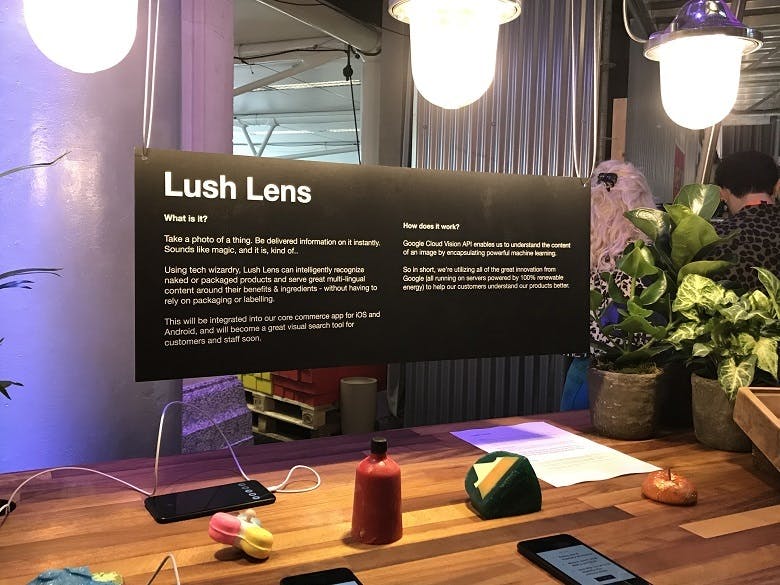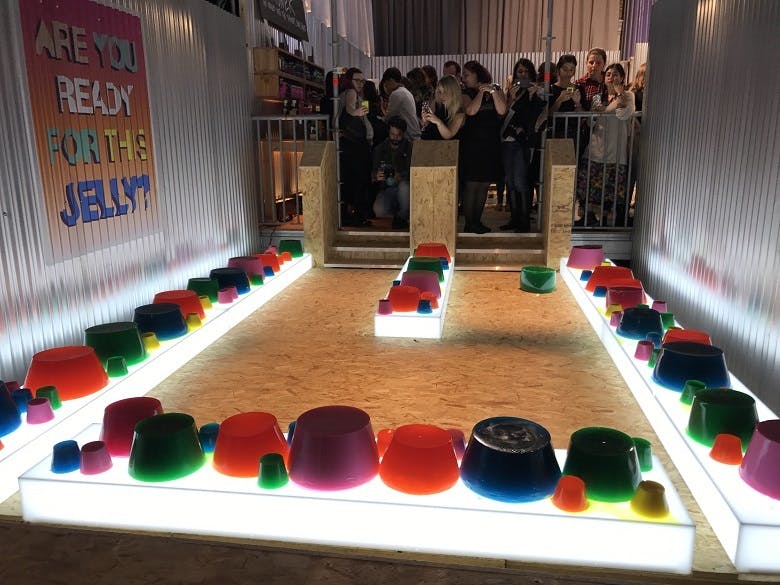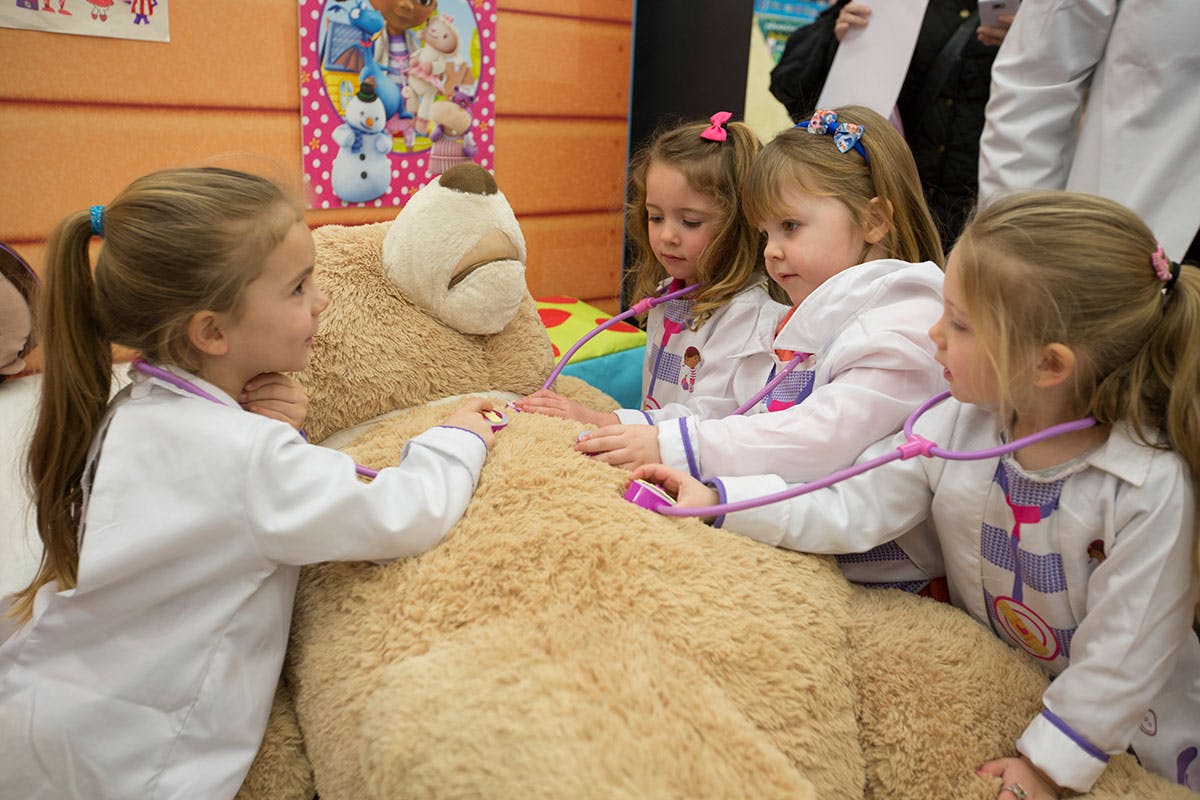The premise is to create a closer bond between the consumer and the brand by immersing them in a fun and memorable experience.
If a brand event stirs genuine positive emotions within people then they are more likely to associate those emotions with that brand, which is more effective than just showing them a Facebook ad or something.
Occasionally the line blurs between experiential marketing and a straightforward PR stunt, but we’re not here to waste time quibbling over definitions.
Here are 10 great examples of experiential marketing. We’ve included relevant success metrics where they are available, but others I’ve included just because they’re pretty darn cool…
Learn more
Download Econsultancy’s Experiential Marketing Best Practice Guide
1. Ghostbusters movie: Marshmallow Man causes havoc at Waterloo station
Commuters in London in 2016 were amazed to see the Stay Puft Marshmallow Man emerging through the concourse floor of Waterloo station.
As our writer Nikki Gilliland reports, “with research finding that unexpected events can result in more pleasure responses in the brain, brands are increasingly searching for ways to ‘surprise’ and ‘delight’ consumers.”
This campaign certainly did that.
Forbidden Planet also ran a popup shop on the same theme in Waterloo, built to look like a New York subway station, and allowing commuters to buy movie tickets and souvenirs.
Our #ghostbusterswaterloo booth is now open from 8am to 8pm – for all your #Ghostbusters goodies! pic.twitter.com/ikJdMnxcvH
— Forbidden Planet (@ForbiddenPlanet) July 15, 2016
Using the hashtag #ghostbusterswaterloo, the stunt was a hit on Instagram, with lots of people taking advantage of a unique photo opportunity.
2. Coca Cola’s 2018 World Cup AR experience
Coca Cola celebrated the start of the 2018 Fifa World Cup with an augmented reality experience outside of Zurich train station.
Participants could show off their skills on screen with Switzerland’s Xherdan Shaqiri, take a photo with The Powercube (one of his many nicknames) and enter a competition to win the official match ball of the Fifa World Cup.
An immersive experience using AR on a grand scale was a great way to engage true football fans and give them a memory tied to the Coca-Cola brand and the world’s biggest sporting event.
3. WaterAid’s Hope Lockers
WaterAid worked with Proximity and MediaMonks in 2016 to create its Hope Lockers.
As the video explains, screens within the lockers play a video when swimmers return to their locker – giving them information about the plight of those without clean water, and telling swimmers how many children died in the time they were swimming as a result of dirty water.
At the end of the message, the swimmer is asked whether they want their pound coin returned or whether they would like to donate it to the cause.
Swimmers’ attention has to be focused on the campaign to get their pound coin back, making this a captive moment. Of course, the lockers would probabaly not be profitable at scale but were used as a PR/experiential tool to drive awareness via word of mouth and press coverage.
Click to enlarge.
4. Doc McStuffin’s check up clinic
Doc McStuffin is a Disney Channel TV show about a six-year-old girl who heals toys out of her imaginary clinic.
If you’ve not heard of it, I’ll get my seven-year-old niece to sing you the theme tune.
To promote the second series in 2014 and increase merchandise sales Disney recreated Doc’s clinic in Tesco, Smyths and Toys R Us in the UK.
Children were given a 10-minute immersive experience where they took the role of Doc and diagnosed what was wrong with Big Ted.

Children waiting for their turn were able to play with Doc McStuffin merchandise, do colouring in, or watch clips from the TV show.
Almost 8,000 children took part in the experience, 75% of whom rated it as ‘excellent’ (I’m assuming they surveyed their parents).
Most importantly, it created a 5.3% increase in the propensity to buy merchandise.
5. The Simpsons Movie: 7-Eleven’s transformed into Kwik-E-Marts
Okay, so this is an old example, but I really liked it so here it is.
Back in 2007 20th Century Fox partnered with 7-Eleven to transform 12 of its stores into Kwik-E-Marts, the shop run by Apu in The Simpsons.
It was all to promote the release of The Simpsons Movie.

The Kwik-E-Marts offered limited quantities of KrustyO’s cereal, Buzz Cola, and Squishee frozen drinks.
A special edition of a Radioactive Man comic book was also produced just for 7-Eleven, while life-size citizens of Springfield could be seen in the stores.
6. The Lush Creative Showcase
Cosmetics brand Lush runs an annual Creative Showcase both to promote new products as well as its digital and ethical credentials.
Together we can work towards a better, fairer future. That's what @jeremycorbyn put forward at the #CreativeShowcase https://t.co/3dCJdhQrbQ pic.twitter.com/PPHf9PWdmH
— LUSH UK (@LushLtd) September 4, 2017
This ticketed event allows Lush fans to get up close and personal with the brand. Nikki Gilliland reported in 2017 on visual and voice search, alongside Instagrammable installations.

Lush stores of course already give an immersive experience with their staff giving demonstrations of products. The Showcase takes this personable approach further by getting super fans involved on a grand scale.

7. Samsung Studios – 2012 Olympics
As part of its sponsorship of the 2012 Olympics, Samsung created brand experiences at various destinations around London, including St Pancras International, Stratford International, Westfield Stratford, N1 Centre Islington, Canary Wharf, One New Change, Broadgate and Heathrow T1 departures lounge.
Running from mid July to early September the ‘Samsung Studios’ focused on demonstrating the new Galaxy S3 and Galaxy Note.
Visitors could play with Samsung’s Olympic Games app or have their photo taken on the Galaxy S3 and instantly turned into a personalised badge.
There was also a competition to win an S3 and an around-the-world trip if people could be bothered to return every day to collect special pin badges.
Notably, no products were sold at the Studios.

Analysis showed that half the visitors spent between six and ten minutes at the Samsung Studio, while the average interaction was 7 minutes 45 seconds.
For those in the market for a new phone, the average interaction was 8 minutes 15 seconds.
Among various other results, nine of out ten visitors claimed to be more likely to consider a Samsung phone as a result of having interacted with the Samsung Studio.
And just over a third (35%) said they are much more likely to consider Samsung.
How Samsung uses social listening for product marketing and sentiment analysis
8. Adidas and Derrick Rose’s Jump Store
Pop-up stores aren’t a new concept, but Adidas’ 2013 ‘D Rose Jump Store’ in London was a cut above the rest.
Chicago Bulls point guard Derrick Rose was in attendance to challenge fans to win a pair of free trainers by taking them off a shelf that happened to be 10 foot in the air.
It’s a relevant, exciting and memorable experience for all the kids who took part.
9. Mountain Dew’s UK ‘guerrilla tour’
I’m not even sure if you can buy Mountain Dew in the UK anymore, so maybe they should carry out more of these kind of stunts.
To drive awareness and encourage people to try Mountain Dew Energy the marketing team designed a 43-day ‘guerrilla tour’ in 2012 that targeted consumers at festivals, transport hubs and in city centres.
A team of 15 brand ambassadors drove around the UK in a Mountain Dew truck, hosting various competitions and giveaways. They also dished out free samples.
This video explains more:
The campaign achieved an ROI of £1.85 for every £1 spent, and 55% of people targeted by the event went on to purchase a Mountain Dew, more than a third of whom were new purchasers.
10. IKEA’s store sleepover
In the UK Ikea hosted a sleepover in 2011 in its Essex store in response to a Facebook fan group called ‘I wanna have a sleepover in Ikea’.
Almost 100,000 people joined the group and Ikea gave 100 of them the chance to actually spend a night in the warehouse.
The winners were given manicures and massages, and had a bedtime story read to them by a reality TV star.
There was also a sleep expert on-hand to give people advice and potentially help them choose a new mattress.




This is proof that when your business makes multimillions you can play with it!
Truly exciting guest blog. Very cool examples you shared here. To achieve business success in minimal time, you must prefer to hire the best experiential marketing agency.